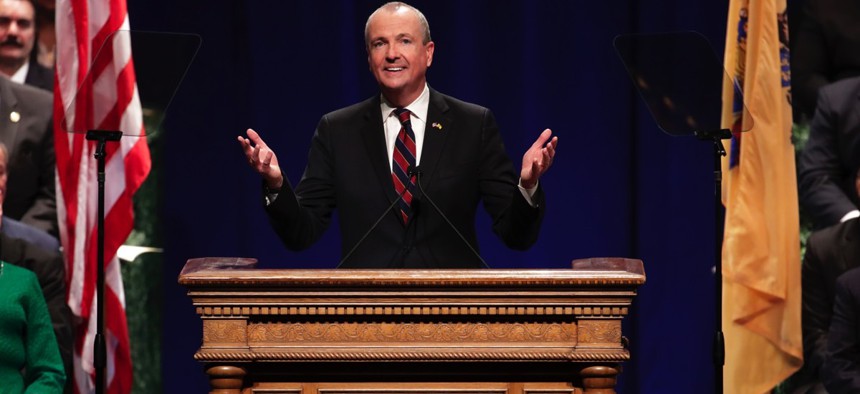New N.J. Governor Re-Enters Regional Climate Pact, Reversing Move By Christie

New Jersey Gov. Phil Murphy Julio Cortez / A.P. Photo
The Garden State joins others regulating emissions absent federal policy.
New Jersey Gov. Phil Murphy’s decision to re-enter the Regional Greenhouse Gas Initiative is the latest example of a state government filling the Trump administration’s carbon regulatory void, one that will likely raise local electricity rates, according to Moody’s Investors Service.
In 2011, then-Gov. Chris Christie exited the RGGI, a 10-state partnership that caps greenhouse gas emissions from fossil-fueled power plants. The current cap is 91 million short tons and declines 2.5 percent every year through 2020.
Member states hold carbon allowance credit auctions, the proceeds from which are reinvested in clean energy initiatives.
“Pulling out of RGGI slowed down progress on lowering emissions and has cost New Jerseyans millions of dollars that could have been used to increase energy efficiency and improve air quality in our communities,” Murphy said in the announcement.
Fossil-fueled power plants must reduce carbon emissions by either decreasing energy output or buying more credits, the cost of which they offset by increasing the price of electricity.
The real winner in the equation is PSEG Power, New Jersey’s largest nuclear power plant operator, which will benefit from increased electricity prices without having to alter its business practices because it’s not a greenhouse gas emitter, per Moody’s latest credit outlook.
Since President Trump announced in June his plans to withdraw the U.S. from the international Paris Agreement, more than 1,200 cities, counties, states, and private sector stakeholders reaffirmed their commitment to the climate accord’s goals—many with policy action.
“States with pending legislation for a carbon tax include Washington and Massachusetts, while Arizona recently announced an 80% clean energy portfolio standard by 2050,” reads the Moody’s report. “Such state-level initiatives indicate a broader trend toward clean energy across the country.”
For climate-minded government officials, an increase in residents’ electricity rates seems a small price to pay for reduced greenhouse gas emissions and renewable energy.
Freeport, New York Mayor Robert Kennedy commented in late January at the U.S. Conference of Mayors winter meeting in Washington, D.C. that municipal electricity sales had taken a hit with the local introduction of renewables. Electricity prices were raised as a result.
“Think about the cost to the country of dealing with millions if not billions of people having to be relocated in the world because of coastal flooding, about the billions of dollars spent from adverse weather,” Carmel, Indiana Mayor Jim Brainard said in response. “That increase in rates is going to be miniscule compared to the potential impact of climate change, if we don’t get it under control.”
New Jersey’s new governor appears of the same mind.
Since announcing RGGI re-entry, Murphy also withdrew New Jersey from a lawsuit attempting to reverse Obama-era Clean Power Plan regulations, established offshore wind energy goals for the state, backed a “fracking” ban in the Delaware River basin, and opposed a federal proposal for offshore drilling along the outer continental shelf.
“Five years ago, New Jersey faced Superstorm Sandy. That storm and the devastation it brought to our state was an all-too-real look at our new normal if we do not take climate change seriously,” Murphy said in a statement. “As the densest state in the nation, we cannot afford to keep our heads in the sand any longer.”
Dave Nyczepir is a News Editor with Government Executive’s Route Fifty and is based in Washington, D.C.
NEXT STORY: Some Hospitals in Appalachia See Surges of Opioid Babies






